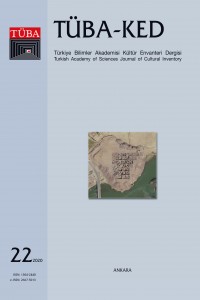İMPARATOR’UN DÖNÜŞÜ: NICOMEDIA FRIZINE AİT ÇALINAN İMPARATOR RÖLYEFİ’NİN TEKNİK VE İKONOGRAFİK DEĞERLENDİRMESİ
Abstract
Bu makale 2009 İzmit (Nicomedia) Çukurbağ Kurtarma Kazıları sonrasında çalınan ve 2019 yılında Türkiye Anıtlar
ve Müzeler Müdürlüğü Kaçakçılıkla Mücadele Dairesi’nin girişimleri ile bulunduğu Almanya Münih’ten, ait olduğu
Kocaeli Arkeoloji Müzesi’ne getirilen Geç Roma Dönemi boyalı mermer kabartmasının (rölyef paneli) ilk akademik
değerlendirmesini ve belgelenmesini içerir. Detaylı teknik ve ikonografik incelemede, rölyef panelinin MS. 3.
yüzyıl sonunda başkent Nicomedia’da, ikili imparatorlar Diokletianus ve Maximianus döneminde inşa edilmiş olan
dev imparatorluk kompleksinin içini süsleyen ve toplam uzunluğu 55 metreyi bulan boyalı mermer rölyef frizinin
bir parçası olduğu anlaşılmıştır. Rölyef paneli, kaçırılma sırasında kırılan ve Kocaeli Arkeoloji Müzesi deposunda
bekletilen diğer küçük parçaları ile birleştirilerek orijinal bağlamında yeniden değerlendirilmiştir. Rölyefin üzerinde
bir değil iki imparatorun, aralarında da çelenk tutan tanrıça Nike’nin tasvir edildiği ve panelin Nicomedia frizinin diğer
panelleriyle birlikte, imparatorluk kompleksinin içindeki entabletüre yerleştirildikten sonra boyandığı anlaşılmıştır.
Rölyef üzerinde iyi korunan boyalar üzerinde yapılan mikroskobik inceleme eserin yapımında kullanılan pigment
içerikleri ve ikonografik anlatımda renk kodları gibi birçok yeni veriye ulaşmamızı sağlamıştır. İmparatorlarının
savaş zaferini simgeleyen rölyef, Nicomedia frizindeki diğer imparatorluk tasvirleri gibi, imparatorluk kültü tapınımı
ve kutlamaları çerçevesinde kullanılmıştır.
References
- ABBE, M. B. ve T. ŞARE AĞTÜRK. 2019. ‘The New Corpus of Painted Imperial Roman Marble Reliefs from Nicomedia: A Preliminary Report on Polychromy’, Technè, 48: 101–10.
- ADAM, J. 1994. Roman Building: Materials and Techniques, London: Batsford.
- AYLWARD, W. 2009. ‘Lewises in Hellenistic and Roman Building at Pergamon’, in M. Bachmann (ed.), Bautechnik im Antiken und vorantiken Kleinasien, BYZAS, 9, Istanbul: Ege Yayınları, 309–22.
- BARNES, T. D. 1982. The New Empire of Diocletian and Constantine, Cambridge: Harvard University Press.
- BARNES, T. D. 1996. ‘Emperors, Panegyrics, Prefects, Provinces and Palaces (284–317)’, Journal of Roman Archaeology, 9: 532–52.
- BINGÖL, O. 2004. Antik Mimari’de Taş, İstanbul: Homer Kitabevi.
- CORCORAN, S. 2000. The Empire of the Tetrarchs: Imperial Pronouncements and Government, AD 284–324, Oxford: Oxford University Press.
- KLOSE, C. 2015. ‘A Farewell to Methods?’ , in C. Klose, L. C. Bossert, and W. Leveritt (eds), Fresh Perspectives on Graeco- Roman Visual Culture: Proceedings of an International Conference at the Humboldt-Universität, Berlin, 2nd–3rd September 2013, Berlin: Humboldt-Universität, 99–116.
- KOEPPEL, G. 1969. ‘Profectio und Adventus’, Bonner Jahrbücher des Rheinisches Landesmuseums in Bonn, 169: 130–94.
- KOLB, F. 1987. Diocletian und die erste Tetrarchie: Improvisation oder Experiment in der Organisation monarchischer Herrschaft, Berlin: Walter de Gruyter.
- REES, R. 2004. Diocletian and the Tetrarchy, Edinburgh: Edinburgh University Press.
Details
| Primary Language | Turkish |
|---|---|
| Subjects | Cultural Studies |
| Journal Section | Research Articles |
| Authors | |
| Publication Date | December 31, 2020 |
| Submission Date | December 21, 2020 |
| Published in Issue | Year 2020 Issue: 22 |
Cited By
A HEAD OF A STATUE FROM THE BITHYNIAN CITY OF CLAUDIOPOLIS (BOLU)
Türkiye Bilimler Akademisi Arkeoloji Dergisi
https://doi.org/10.22520/tubaar2022.30.005
Publisher
Vedat Dalokay Caddesi No: 112 Çankaya 06670 ANKARA
TÜBA-KED Turkish Academy of Sciences Journal of Cultural Inventory (TÜBA-KED) does not officially endorse the views expressed in the articles published in the journal, nor does it guarantee any product or service advertisements that may appear in the print or online versions. The scientific and legal responsibility for the published articles belongs solely to the authors.
Images, figures, tables, and other materials submitted with manuscripts must be original. If previously published, written permission from the copyright holder must be provided for reproduction in both print and online versions. Authors retain the copyright of their works; however, upon publication in the journal, the economic rights and rights of public communication -including adaptation, reproduction, representation, printing, publishing, and distribution rights- are transferred to the Turkish Academy of Sciences (TÜBA), the publisher of the journal. Copyright of all published content (text and visual materials) belongs to the journal in terms of usage and distribution. No payment is made to the authors under the name of copyright or any other title, and no article processing charges are requested. However, the cost of reprints, if requested, is the responsibility of the authors.
In order to promote global open access to scientific knowledge and research, TÜBA allows all content published online (unless otherwise stated) to be freely used by readers, researchers, and institutions. Such use (including linking, downloading, distribution, printing, copying, or reproduction in any medium) is permitted under the Creative Commons Attribution-NonCommercial-NoDerivatives 4.0 International (CC BY-NC-ND 4.0) License, provided that the original work is properly cited, not modified, and not used for commercial purposes. For permission regarding commercial use, please contact the publisher.

